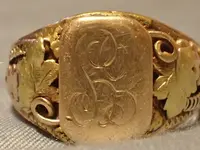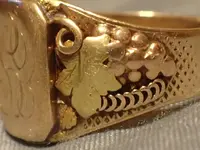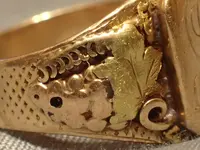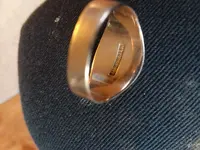Nice find!

This is a common design that's going to be hard to pin down. This same style started in California in the 1850's and traveled east through the mining districts where it was picked up in South Dakota in the 1870's. Shortly thereafter it was marketed as "Black Hills Gold".
It was common practice to mark the state or gold district where the ring was sold followed by "14K" or "
GOLD" depending on whether it was 14 karat or less than 10 karat gold. I've seen rings marked "
NEVADA14K" and "Arizona14K" as well as one marked "GOLDFIELD14K" with virtually identical lettering as yours.
These particular "ALASKA14K" marked rings were sold new to tourists well into the
1960's. Often the store selling the ring would inscribe their name in the band along with the stamp. Yours appears to be an earlier piece and might well date to the 1920's.
Value tends to be high, for a tourist piece, on these type rings. I'd guess yours could sell in the $600 - $1000 range. That's a boatload of money for an old worn 14k ring. If it had the sellers trademark inscribed it could be considerably more.
All these multi color gold designs are made from 24k bullion that has been alloyed with silver (green gold) or copper (red gold). The yellow gold base is composed of an alloy of gold, copper and silver. The bullion gold could have been mined anywhere in the world.
I suspect most of these style rings were made by
Landstrom's in South Dakota or
Suter's in Fairbanks. Landstrom made quite a few in the style of your ring but those would date from the 1940's until the present.
Suter's was a bit earlier and was better known for nugget jewlery through the 1920's.
Beware, there are quite a few of the earlier rings of this style marked "GFB:14K". Those are not 14k gold rings they are just plated with 14k gold over brass. Most of the "ALASKAGOLD" rings are also plated with low karat gold over brass. Yours is clearly 14k gold (not plated) and partially constructed by hand.


















